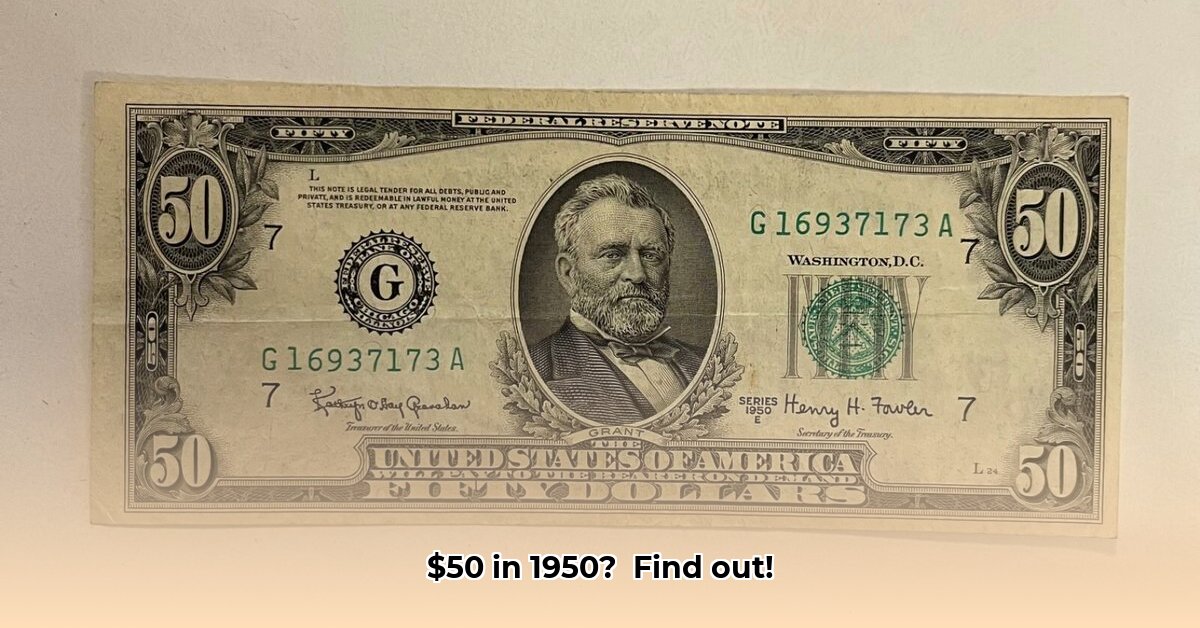
How Much Was $50 Worth in 1950?
Ever wonder what your grandparents could buy with fifty dollars in 1950? It wasn't just pocket change; it held significant buying power. Understanding its value offers a fascinating glimpse into the past and underscores the impact of inflation. This journey back in time reveals more than just numbers; it's a story of economic shifts and financial realities.
A Glimpse into the Post-War Boom
Picture America in 1950: World War II had ended, and the nation was experiencing a period of economic growth. Yet, prices were remarkably low compared to today. A gallon of gas cost around 20 cents—less than a quarter! A new car cost approximately $1,500. This context drastically shifts our understanding of $50 then. It was a substantial sum for many families.
Inflation: The Silent Thief of Purchasing Power
To truly grasp the value of that $50, we must consider inflation—the gradual increase in the price of goods and services over time. The Consumer Price Index (CPI) (a measure of the average change in prices paid by urban consumers for a basket of consumer goods and services) helps us quantify this change. Using online tools that incorporate the CPI 1, we can estimate the equivalent value of $50 in 1950. The calculation reveals it's roughly equivalent to around $600 today—a substantial increase! This illustrates the profound effect of inflation across several decades.
What Could $50 Buy in 1950?
Imagine holding $50 in 1950. A nice suit? A week's worth of groceries for a family? The possibilities were significant. For many, $50 represented a substantial portion of their weekly or monthly budget.
The Compounding Effect of Inflation
Inflation doesn't just increase prices linearly; it compounds. Each year's increase builds on the previous year's, creating a snowball effect. This explains the significant difference between the value of $50 in 1950 and its modern-day equivalent. This compounding effect is a key concept for understanding long-term financial planning. How much more could that $50 have been worth with careful investment?
Beyond the Numbers: Life in the 1950s
While numbers paint a picture, the context of the 1950s is crucial. The era saw economic growth, but it wasn't evenly distributed. $50 meant different things to different families, reflecting the existing financial inequalities.
Investing and Inflation: Lessons for Today
Understanding inflation is key for present-day financial decisions, particularly investing. Your investments must outpace inflation to build wealth over the long term; otherwise, you risk losing purchasing power. Remembering the transformation of $50 across time underscores the importance of long-term financial planning.
Protecting Investments from Inflation: A Historical Perspective
The historical context of inflation since 1950 provides valuable insights into protecting investment portfolios. Various periods witnessed varying inflation rates, influencing investor strategies. The 1970s, for example, demonstrated the impact of high inflation on markets.
Diversification: A Cornerstone of Inflation Resilience
A one-size-fits-all approach to investment protection against inflation is unrealistic. It depends on individual circumstances and risk tolerance. Diversification is key. Assets traditionally viewed as inflation-resistant include:
- Real Estate: Property values tend to rise with inflation, offering a hedge against its effect.
- Commodities: Precious metals (like gold), and other commodities can act as safe havens during inflationary periods. Commodities ETFs provide diversification and liquidity.
- Series I Bonds: These bonds offer inflation-adjusted interest rates, directly counteracting rising prices.
- High-Quality Equities: Well-established companies with strong pricing power can better withstand economic shocks and inflation.
The Long Game: Planning for the Future
Combating inflation is a long-term endeavor. Short-term gains may not reflect the true potential of a well-diversified, inflation-resistant portfolio over the long haul. Consistent, strategic planning is critical to wealth preservation.